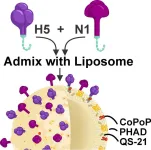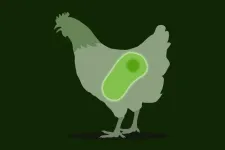(Press-News.org) BUFFALO, N.Y. — A vaccine under development at the University at Buffalo has demonstrated complete protection in mice against a deadly variant of the virus that causes bird flu.
The work, detailed in a study published today (April 17) in the journal Cell Biomaterials, focuses on the H5N1 variant known as 2.3.4.4b, which has caused widespread outbreaks in wild birds and poultry, in addition to infecting dairy cattle, domesticated cats, sea lions and other mammals.
In the study, scientists describe a process they’ve developed for creating doses with precise amounts of two key proteins – hemagglutinin (H5) and neuraminidase (N1) – that prompt the body’s immune system to fight bird flu.
This process – what’s known as a “vaccine platform” – could help set the experimental vaccine apart from the handful of bird flu vaccines approved for human use in the U.S. and Europe which, while effective, have focused almost entirely on H5 and not N1.
It’s also a potential step toward more potent, versatile and easy-to-produce vaccines that public health officials believe will be needed to counteract evolving bird flu strains that grow resistant to existing vaccines.
“We obviously have a lot more work to do, but the results thus far are extremely encouraging,” says the study’s lead author Jonathan Lovell, PhD, professor in the Department of Biomedical Engineering at UB.
Tests show vaccine provides complete protection
Lovell and colleagues tested the vaccine platform in mice with 2.3.4.4b. They used doses containing H5 alone, N1 alone, and H5 and N1 combined. They found that:
H5 alone provided complete protection, with no signs of illness, weight loss nor detectable virus in the lungs.
N1 alone gave partial protection. It was roughly 70% effective, with some mice showing symptoms and viral presence.
H5 and N1 together, which is a bivalent vaccine, also provided complete protection, but it did not outperform H5 alone. Put another way, adding N1 did not offer more protection than H5 alone.
The results, Lovell says, show the important role that H5 plays in developing immunity to bird flu.
In its viral form, H5 acts like a key allowing the virus to enter and attach itself to host cells where it then starts to replicate. Vaccines with small, safe doses of H5 prompt the body to recognize, remember and destroy the problematic intruder.
N1, meanwhile, acts as an enzyme in its viral form. Like a pair of scissors, it clips residues from the host cell, helping the replicated virus spread throughout the body.
“While they are non-neutralizing, N1 antibodies are still incredibly important. They reduce viral replication and the severity of illness,” Lovell says. “These bivalent formulations could be extremely advantageous as H5N1 evolves.”
Vaccine platform underwent COVID clinical trials
Lovell created the vaccine platform and has been experimenting with it for more than a decade. It consists of tiny spherical sacs called nanoparticles, which are made of cobalt and porphyrin with an outer shell of phospholipid – he calls it “CoPoP” for short.
(While not part of this study, the platform underwent phase 2 and phase 3 clinical trials in South Korea and the Philippines as a COVID-19 vaccine candidate. This work was a partnership between UB spinoff company POP Biotechnologies, co-founded by Lovell, and South Korean company EuBiologics.)
To create the experimental bird flu vaccine, the researchers added what’s called a histidine tag, or his-tag, to both the H5 and N1. His-tags are short strings of amino acids that have a natural affinity for metals. When mixed with CoPoP nanoparticles, the his-tag proteins form a strong bond with cobalt ions.
“It’s kind of like a magnet attaching itself to a metal surface. It just clicks into place. It’s fast and efficient, which is advantageous when you need to quickly ramp up vaccine production,” says Lovell.
To make the vaccine more potent, the researchers added two immune-boosting adjuvants – QS-21 and a synthetic monophosphoryl lipid A, or MPLA. The adjuvants are mixed into the phospholipid layer.
Easier to produce than egg-based vaccines
The vaccine is what’s known as a recombinant protein vaccine. Unlike currently approved vaccines, which use live or dead versions of H5N1, it relies on bits of genetic material (H5 and N1) from the virus to stimulate immune response.
“Because our vaccine does not require the use of eggs in the manufacturing process – as many influenza vaccines do – it is potentially a faster and more efficient way to protect humans and animals from deadly strains of bird flu,” Lovell says.
The research team plans additional work on the vaccine candidate, including testing different doses, schedules and conditions.
Study co-authors work at the Jacobs School of Medicine and Biomedical Sciences at UB; National Microbiology Laboratory, which is part of the Public Health Agency of Canada; St. Jude Children’s Research Hospital; POP Biotechnologies; National Center for Foreign Animal Disease, which is part of the Canadian Food Inspection Agency; and the University of Manitoba.
END
Study: Experimental bird flu vaccine excels in animal models
Proven effective for COVID-19, vaccine platform could be key in responding to evolving bird flu strains
2025-04-17
ELSE PRESS RELEASES FROM THIS DATE:
Real-world study finds hydroxyurea effective long-term in children living with sickle cell disease
2025-04-17
(WASHINGTON, April 17, 2024) — Hydroxyurea remains effective long-term in reducing emergency department visits and hospital days for children living with sickle cell disease (SCD), according to new research published in Blood Advances.
“This is one of the first large, real-world, long-term studies to assess the efficacy of hydroxyurea outside of a controlled setting,” said study author Paul George, MD, a pediatric hematology/oncology fellow and PhD candidate at Emory University School of Medicine and Aflac Cancer and Blood Disorders Center at Children’s ...
FAU designated a National Center of Academic Excellence in Cyber Research
2025-04-17
Florida Atlantic University has been recognized as a National Center of Academic Excellence in Cyber Research (CAE-R) by the National Security Agency (NSA) and its partners in the National Centers of Academic Excellence in Cybersecurity (NCAE-C). This prestigious designation, awarded through the academic year 2030, affirms the university’s leadership and innovation in the field of cybersecurity research at the doctoral level.
This recognition places FAU among an elite group of institutions nationwide that have demonstrated a sustained commitment to cutting-edge research in cyber defense and security. The CAE-R designation is awarded to universities whose programs meet rigorous ...
European potato genome decoded: Small gene pool with large differences
2025-04-17
A research team has decoded the genome of historic potato cultivars and used this resource to develop an efficient method for analysis of hundreds of additional potato genomes.
Potatoes are a staple food for over 1.3 billion people. But despite their importance for global food security, breeding successes have been modest. Some of the most popular potato cultivars were bred many decades ago. The reason for this limited success is the complex genome of the potato: there are four copies of the genome in each cell instead of just two. ...
Nontraditional risk factors shed light on unexplained strokes in adults younger than 50
2025-04-17
Research Highlights:
Among adults ages 18-49 (median age of 41 years) who were born with a hole in the upper chambers of their heart known as patent foramen ovale (PFO), strokes of unknown cause were more strongly associated with nontraditional risk factors, such as migraines, liver disease or cancer, rather than more typical factors such as high blood pressure.
Migraine with aura was the top factor linked to strokes of unknown causes, also called cryptogenic strokes, especially among women.
Embargoed ...
Extreme drought contributed to barbarian invasion of late Roman Britain, tree-ring study reveals
2025-04-17
Three consecutive years of drought contributed to the ‘Barbarian Conspiracy’, a pivotal moment in the history of Roman Britain, a new Cambridge-led study reveals. Researchers argue that Picts, Scotti and Saxons took advantage of famine and societal breakdown caused by an extreme period of drought to inflict crushing blows on weakened Roman defences in 367 CE. While Rome eventually restored order, some historians argue that the province never fully recovered.
The ‘Barbarian Conspiracy’ of 367 CE was one of the most severe threats to Rome’s hold on Britain since the Boudiccan revolt three centuries earlier. Contemporary sources indicate that components ...
Antibiotic-resistant E. albertii on the rise in Bangladeshi chicken shops
2025-04-17
If you have ever chickened out of eating chicken, your unease may not have been unreasonable.
Osaka Metropolitan University researchers have detected alarming rates of Escherichia albertii, an emerging foodborne pathogen, in retail chicken meat in Bangladesh. Their findings show extensive contamination and significant antimicrobial resistance, underscoring the potential risks to public health.
E. albertii is a less known but probably not less dangerous relative of E. coli. First described in Bangladesh in 2003, this bacterium ...
Veterinary: UK dog owners prefer crossbreeds and imports to domestic pedigree breeds
2025-04-17
The UK pedigree dog population shrank by a yearly decline of 0.9% between 1990 and 2021, according to research published in Companion Animal Genetics and Health. The study highlights a rise in the populations of crossbreeds and imported pedigree dogs since 1990, but finds that only 13.7% of registered domestic pedigree dogs were used for breeding between 2005 and 2015.
There are more than 400 breeds of dogs globally, characterised by different appearances and behaviours. While the overall population of pet dogs in the UK ...
Study links climate change to rising arsenic levels in paddy rice, increasing health risks
2025-04-16
Climate change may significantly impact arsenic levels in paddy rice, a staple food for millions across Asia, reveals a new study from Columbia University’s Mailman School of Public Health. The research shows that increased temperatures above 2°C, coupled with rising carbon dioxide (CO2) levels, lead to higher concentrations of inorganic arsenic in rice, potentially raising lifetime health risks for populations in Asia by 2050. Until now, the combined effects of rising CO2 and temperatures on arsenic accumulation in rice have not been studied in detail. The research done ...
Study indicates that risky surgery after a stroke due to carotid artery stenosis is no longer necessary for majority of patients
2025-04-16
European research led by University College London (UCL), together with Amsterdam UMC and the University of Basel shows that a significant proportion of patients who suffer a stroke due to carotid artery narrowing can be treated with medication only. A risky carotid artery operation, currently still the standard treatment for many patients, may then no longer be necessary for this group of patients. This research, published today in the Lancet Neurology, may lead to the global guidelines for the treatment of these patients being adjusted.
In the Netherlands, about 2,000 people with carotid artery stenosis ...
Blood pressure: New research shows a changing climate may jeopardise global blood supply
2025-04-16
Blood pressure: New research shows a changing climate may jeopardise global blood supply
A new study published in The Lancet Planetary Health suggests a changing climate threatens the continuous availability of safe blood across the world.
Researchers at the University of the Sunshine Coast and Australian Red Cross Lifeblood say health issues, the spread of infectious disease and extreme weather exacerbated by climate change will impact the ability of people to donate, and at the same time may trigger a rise in the need for blood.
Lifeblood researcher and UniSC Adjunct Research Fellow Dr Elvina Viennet said this ...
LAST 30 PRESS RELEASES:
Making lighter work of calculating fluid and heat flow
Normalizing blood sugar can halve heart attack risk
Lowering blood sugar cuts heart attack risk in people with prediabetes
Study links genetic variants to risk of blinding eye disease in premature infants
Non-opioid ‘pain sponge’ therapy halts cartilage degeneration and relieves chronic pain
AI can pick up cultural values by mimicking how kids learn
China’s ecological redlines offer fast track to 30 x 30 global conservation goal
Invisible indoor threats: emerging household contaminants and their growing risks to human health
Adding antibody treatment to chemo boosts outcomes for children with rare cancer
Germline pathogenic variants among women without a history of breast cancer
Tanning beds triple melanoma risk, potentially causing broad DNA damage
Unique bond identified as key to viral infection speed
Indoor tanning makes youthful skin much older on a genetic level
Mouse model sheds new light on the causes and potential solutions to human GI problems linked to muscular dystrophy
The Journal of Nuclear Medicine ahead-of-print tip sheet: December 12, 2025
Smarter tools for peering into the microscopic world
Applications open for funding to conduct research in the Kinsey Institute archives
Global measure underestimates the severity of food insecurity
Child survivors of critical illness are missing out on timely follow up care
Risk-based vs annual breast cancer screening / the WISDOM randomized clinical trial
University of Toronto launches Electric Vehicle Innovation Ontario to accelerate advanced EV technologies and build Canada’s innovation advantage
Early relapse predicts poor outcomes in aggressive blood cancer
American College of Lifestyle Medicine applauds two CMS models aligned with lifestyle medicine practice and reimbursement
Clinical trial finds cannabis use not a barrier to quitting nicotine vaping
Supplemental nutrition assistance program policies and food insecurity
Switching immune cells to “night mode” could limit damage after a heart attack, study suggests
URI-based Global RIghts Project report spotlights continued troubling trends in worldwide inhumane treatment
Neutrophils are less aggressive at night, explaining why nighttime heart attacks cause less damage than daytime events
Menopausal hormone therapy may not pose breast cancer risk for women with BRCA mutations
Mobile health tool may improve quality of life for adolescent and young adult breast cancer survivors
[Press-News.org] Study: Experimental bird flu vaccine excels in animal modelsProven effective for COVID-19, vaccine platform could be key in responding to evolving bird flu strains



